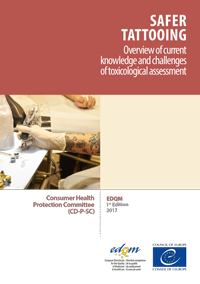Tattoos and permanent make-up - Focus and activities
Safety of intradermal inks
Although the use of tattoos and permanent make-up (PMU) has become increasingly common across all sections of society, the practice still carries intrinsic risks. Cases of intradermal inks becoming microbiologically contaminated are well documented, and protocols for the toxicological risk assessment of tattoo inks and PMUs require further development by the international scientific community. With its scientific expertise, the EDQM aims to support and guide the work of health authorities and manufacturers concerned with the risk assessment of intradermal ink products.
Toxicological assessment
Many substances, impurities and contaminants present in inks may have harmful effects on human health, either as single ingredients or by interaction. The toxicological assessment of inks requires a different approach to that used for traditional cosmetic products due to their intradermal, rather than dermal, route of exposure. In addition, market surveillance for tattoos is rendered more complex by the facts that the typical ink may consist of up to 15 different ingredients and that the choice of ingredients allowed in tattoo inks is very wide.
The EDQM on intradermal inks

In October 2017, the EDQM published a compilation of safety and documentation requirements for tattoos and permanent make-up, which implements the recommendations of Council of Europe Resolution AP (2008) 1 on tattoos and permanent make-up.
- The paper version of this Compendium is available for purchase at the EDQM Store
- The electronic version of this Guide can be downloaded for FREE online
All activities in this field are driven by the EDQM’s Consumer Health Protection Committee (CD-P-SC) composed of experts nominated by the member states.
The other EDQM publications in the field of consumer health protection can be found here.
More information on this topic
The US Food and Drug Administration (FDA) presents key questions for consumers to consider before getting a tattoo. The FDA’s Office of Cosmetics and Colors explains what to do in the case of an infection or other reaction and provides information on the difficulties to remove a tattoo. For more information, please click here.
The Danish Environmental Protection Agency (EPA) published a report on allergy and tattoo in 2017 following the recommendations on the safety of tattoo ink given in 2014. Already in 2012, they analysed 65 tattoo inks and identified chemical substances such as lead, nickel, cadmium, PAH, aniline and o-anisidine. For more information, please click here.
Benefit from free shipping charges by ordering online!



